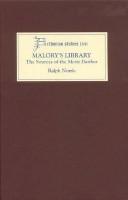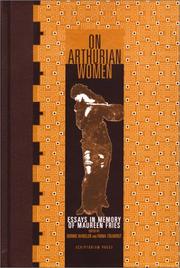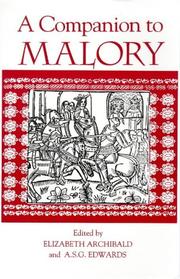| Listing 1 - 10 of 18 | << page >> |
Sort by
|

ISBN: 9004083707 Year: 1987 Publisher: Leiden Brill
Abstract | Keywords | Export | Availability | Bookmark
 Loading...
Loading...Choose an application
- Reference Manager
- EndNote
- RefWorks (Direct export to RefWorks)
Book
ISBN: 0020225601 Year: 1982 Publisher: London : Collier Macmillan,
Abstract | Keywords | Export | Availability | Bookmark
 Loading...
Loading...Choose an application
- Reference Manager
- EndNote
- RefWorks (Direct export to RefWorks)
MALORY (THOMAS) --- MORTE DARTHUR --- MALORY (THOMAS) --- MORTE DARTHUR
Book
Abstract | Keywords | Export | Availability | Bookmark
 Loading...
Loading...Choose an application
- Reference Manager
- EndNote
- RefWorks (Direct export to RefWorks)
Book
ISBN: 2901104363 9782901104360 Year: 1994 Publisher: Aix-en-Provence CUERMA
Abstract | Keywords | Export | Availability | Bookmark
 Loading...
Loading...Choose an application
- Reference Manager
- EndNote
- RefWorks (Direct export to RefWorks)
Old French language --- French language --- Français (Langue) --- Arthurian romances --- History and criticism. --- Français (Langue) --- Arthurian romances - History and criticism. --- Mort artu --- Morte darthur

ISBN: 1282620991 9786612620997 1846156599 1843841541 Year: 2008 Publisher: Cambridge ; Rochester, NY : D.S. Brewer,
Abstract | Keywords | Export | Availability | Bookmark
 Loading...
Loading...Choose an application
- Reference Manager
- EndNote
- RefWorks (Direct export to RefWorks)
A New study of Malory's sources reveals much about how the work was created and about Malory himself. The first book-length study of the sources of Sir Thomas Malory's 'Morte Darthur' since 1921 and the first comprehensive study since that of Vinaver's three-volume edition, 'Malory's Library' collects the results of over one hundred years of scholarship, providing new discussions of the major sources of the eight tales recognised in the standard edition. It also, for the first time, explores possible minor sources of the 'Morte Darthur', evaluating the case for them to see what conclusions may be drawn of Malory's life, work, and mental furnishings. In so doing, it clarifies the process by which Malory created his work. It shows that Malory carried an eclectic body of literature in his mind and worked at least partly from memory; and it illuminates his interest in characters of his own social class, the breadth of his enthusiasm for Arthurian literature, and the depth of his commitment to provide his countrymen with 'the hoole book of kyng Arthur and of his noble knyghtes of the Round Table'. RALPH NORRIS teaches in the Department of English at Kennesaw State University.
Arthurian romances --- History and criticism. --- Malory, Thomas, --- Sources. --- Arthurian literature. --- Malory. --- Morte Darthur. --- Round Table. --- author. --- chivalry. --- creation. --- literature. --- medieval literature. --- noble knights. --- sources.
Book
ISBN: 1787444120 1843845199 Year: 2019 Publisher: Suffolk : Boydell & Brewer,
Abstract | Keywords | Export | Availability | Bookmark
 Loading...
Loading...Choose an application
- Reference Manager
- EndNote
- RefWorks (Direct export to RefWorks)
An examination of the numerous adaptations of Malory's Morte Darthur for children in the nineteenth and twentieth centuries.
Arthurian romances --- Adaptations. --- History and criticism. --- Malory, Thomas, --- Mėlori, Tomas, --- Criticism and interpretation. --- Morte d'Arthur (Malory, Thomas, Sir) --- Birth, life, and acts of King Arthur (Malory, Thomas, Sir) --- Caxton's Malory (Malory, Thomas, Sir) --- Sir Thomas Malory's Le morte d'Arthur (Malory, Thomas, Sir) --- Sir Thomas Malory's Morte Darthur (Malory, Thomas, Sir) --- Arthurian Legend. --- British and American Literature. --- Child Psychology. --- Juvenile Audience. --- King Arthur. --- Malory's Morte Darthur. --- University of Oslo. --- Victorian Medievalism.

ISBN: 0965187713 Year: 2001 Publisher: Dallas, Tex. Scriptorium
Abstract | Keywords | Export | Availability | Bookmark
 Loading...
Loading...Choose an application
- Reference Manager
- EndNote
- RefWorks (Direct export to RefWorks)
Comparative literature --- Thematology --- Arthur [King] --- anno 500-1499 --- Arthurian romances --- Literature, Medieval --- Scholars, Medieval --- Women in literature. --- Women scholars --- History and criticism. --- King Arthur [Fictitious character] --- MALORY (THOMAS) --- SHEELA-NA-GIG --- SIR GAWAIN AND THE GREEN KNIGHT --- CHRETIEN DE TROYES --- BYATT (A.S.) --- GENDER STUDIES --- WOMEN IN LITERATURE --- SEX ROLE IN LITERATURE --- WOLFRAM VON ESCHENBACH, POETE ALLEMAND, 1170?-1220? --- MORTE DARTHUR --- POSSESSION
Book
ISBN: 9780754661429 0754661423 9781315549200 9781317004912 Year: 2008 Publisher: Aldershot Ashgate
Abstract | Keywords | Export | Availability | Bookmark
 Loading...
Loading...Choose an application
- Reference Manager
- EndNote
- RefWorks (Direct export to RefWorks)
Unique in combining a comprehensive and comparative study of genre with a study of romance, this book constitutes a significant contribution to ongoing critical debates over the definition of romance and the genre and artistry of Malory's Morte Darthur. K.S. Whetter offers an original approach to these issues by prefacing a comprehensive study of romance with a wide-ranging and historically diverse study of genre and genre theory. In doing so Whetter addresses the questions of why and how romance might usefully be defined and how such an awareness of genre-and the expectations that come with such awareness-impact upon both our understanding of the texts themselves and of how they may have been received by their contemporary medieval audiences. As an integral part the study Whetter offers a detailed examination of Sir Thomas Malory's Le Morte Darthur, a text usually considered a straightforward romance but which Whetter argues should be re-classified and reconsidered as a generic mixture best termed tragic-romance. This new classification is important in helping to explain a number of so-called inconsistencies or puzzles in Malory's text and further elucidates Malory's artistry. Whetter offers a powerful meditation upon genre, romance and the Morte which will be of interest to faculty, graduate students and undergraduates alike.
Malory, Thomas --- Romances, English --- English literature --- Literary form --- Arthurian romances --- Narration (Rhetoric) --- Gattungstheorie. --- Romance. --- Artursagan. --- Narratologi --- Arthurian romances. --- Literary form. --- Narration (Rhetoric). --- Romances, English. --- History and criticism. --- History --- historia --- Middle English. --- Malory, Thomas, --- Malory, Thomas. --- Le morte Darthur. --- Morte d'Arthur (Malory, Thomas, Sir). --- To 1500. --- Mittelenglisch.

ISBN: 0859915204 Year: 1997 Publisher: Woodbridge Brewer
Abstract | Keywords | Export | Availability | Bookmark
 Loading...
Loading...Choose an application
- Reference Manager
- EndNote
- RefWorks (Direct export to RefWorks)
091 MALORY, THOMAS --- 091 MALORY, THOMAS Handschriftenkunde. Handschriftencatalogi--MALORY, THOMAS --- Handschriftenkunde. Handschriftencatalogi--MALORY, THOMAS --- Arthurian romances --- Kings and rulers in literature --- Knights and knighthood in literature --- Romances, English --- History and criticism --- Malory, Thomas, --- Malory, Thomas --- Romances [English ] --- Malory, Thomas, - Sir, - 15th cent. - Morte d'Arthur. --- MALORY (THOMAS) --- MORTE DARTHUR
Book
ISBN: 1787446336 1787445178 9781787445178 9781843845270 184384527X Year: 2019 Publisher: Cambridge D.S. Brewer
Abstract | Keywords | Export | Availability | Bookmark
 Loading...
Loading...Choose an application
- Reference Manager
- EndNote
- RefWorks (Direct export to RefWorks)
Castles play an integral part in Malory's Morte Darthur; Camelot, Tintagel, Joyous Gard, and Dover, for example, are the crucial backdrop to the action and both host and shape the story as it moves through them. But despitethis, Malory's castles have received limited scholarly attention. As the first monograph to look extensively at either castles or space in Malory, this book aims to fill that gap. It reads the Morte through its castles - their architecture, structural and symbolic significance, and geographical locations, together with their political, communal, ritual, domestic, and martial functions. The book also traces the mutual development of space and identity in the text, looking at Malory's Arthurian community in and around castle space, both as individuals and as a group; for example, it considers Arthur's political success through his use of space, and shows how crucial Camelot and its hall are to the fellowship of knights. Overall, the volume suggests a better understanding of the community's central organising body, the Round Table, and offers important re-readings of a number of episodes and characters.
Knights and knighthood --- Arthurian romances --- Castles in literature. --- Knights and knighthood in literature. --- Space in literature. --- Electronic books. --- History --- History and criticism. --- Malory, Thomas, --- Books in machine-readable form --- Digital books --- E-books --- Ebooks --- Online books --- Books --- Electronic publications --- Knighthood --- Civilization, Medieval --- Nobility --- Chivalry --- Heraldry --- Orders of knighthood and chivalry --- Arthur. --- Camelot. --- Castles. --- Dover. --- Lancelot. --- Malory. --- Morte Darthur. --- Tintagel. --- gender. --- prison.
| Listing 1 - 10 of 18 | << page >> |
Sort by
|

 Search
Search Feedback
Feedback About UniCat
About UniCat  Help
Help News
News